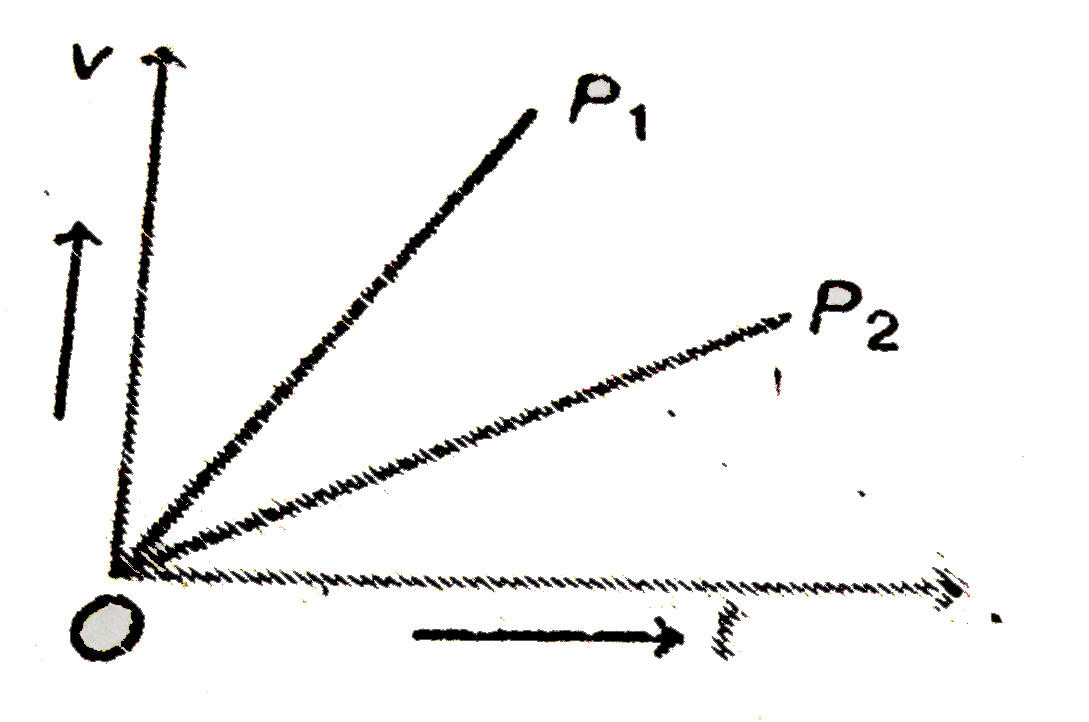
A particle can travel point A to B from two different path 1 and 2, as shown, in same interval of time. Then which of the following is incorrect?
Averrage velocity along the two paths A to B are equal
The particle may traval along both the paths unaccelerated
The direction of instantaneous velocity along the path 1 & 2 can be same for a maximum of two point on the paths.
Along pasth 1 the avarage and instantaneous velocity can have same direction at some instant
The correct Answer is:B
A particle ……….
As displacement for both paths is same. Hence average velocity along two paths must be equal. As direction of pasrticle for path 1 changes hence velocity changes therefore motion is accelerated. The direction of average velocity & instaneous velocity can be shown as

Similar Questions
The displacement-time graph of two moving objects A and B are shown in the figure given below. Which of the following is incorrect?

View SolutionBholu and Golu are playing in a ground. They start running from the same point A in the ground and reach point B at the same time by following the paths marked 1 and 2 respectively as shown in Fig. Which of the following is/are true for the given situation.

As compared to Golu, Bholu covers a
View Solution
Knowledge Check
An ideal gas is taken from state A to state B following three different paths as shown in P-V diagram. Which one of the following is true ?
 Awork done is maximum along ABBwork done is minimum along ABCwork done along ACB = work done along ADBDwork done along ADB is minimum.
Awork done is maximum along ABBwork done is minimum along ABCwork done along ACB = work done along ADBDwork done along ADB is minimum.A block is raised from position A to B by taking two different paths as shown in the figure. If AB = h, then
 Athe work done on the block is greater in case of path 1 than in case of path 2Bthe work done on the block is greater in case of path 2 than in case of path 1Cthe work done on the block is same for both pathsDthe work done cannot be determined.
Athe work done on the block is greater in case of path 1 than in case of path 2Bthe work done on the block is greater in case of path 2 than in case of path 1Cthe work done on the block is same for both pathsDthe work done cannot be determined.Two particles are projected simultaneously from the same point, with the same speed, in the same vertical plane, and at different angles with the horizontal in a uniform gravitational field acting vertically downwards. A frame of reference is fixed to one particle. The position vector of the other particle , as observed from this frame, is →r. Which of the following statement is correct?
A→r is a constant vector.B→r changes in magnitude as well as direction with time.CThe magnitude of →r increases linearly with time, its direction does not change.DThe direction of →r changes with time, its magnitude may or may not change, depending on the angles of projection.
A particle covers equal distance around a circular path, in equal intervals of time. Which of the following quantities connected with the motion of the particle remains constant with time?
View SolutionTwo wheels A and B are released from rest from points X and Y respectively on an inclined plane as shown in the figure. Which of the following statement(s) is/are incorrect?

View SolutionShown in the figure are the velocity time graphs of the two particle P1 and P2 moving in same straight line in same direction. Which of the following statements about their relative motion is true?

Their relative velocity
View SolutionTwo particles are projected from the same point, with the same speed, in the same vertical plane, at different angles with the horizontal.A frame of references is fixed to one particle.The position vector of the other particle as observed from this frame is →rWhich of the following statements are corrects?
View SolutionA particle travels from A to B path shown in figure, then the displacement of particle is :
 .
.
View Solution